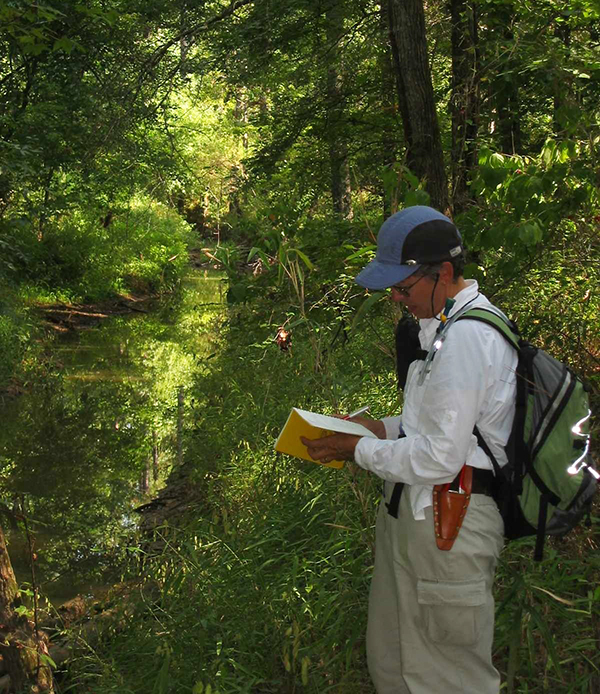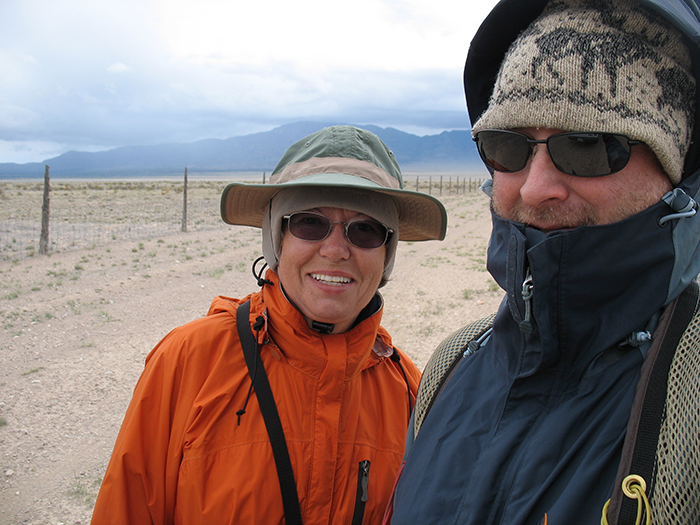BY TIM SCHOMMER
Nancy Hastings came to Colorado State University in 1989 to pursue a graduate degree in Range Science. After graduating four years later, she began a 34-year career as a botanist with CSU’s Center for Environmental Management of Military Lands (CEMML), helping military installations across the U.S. and overseas manage their natural resources.
Nancy was born in Georgia, the daughter of a career Air Force/Army serviceman. She grew up on various installations throughout the southeast. By the time she was in high school, her father had retired from military service and the family moved to northern Georgia, where her mother was from. She graduated from North Georgia College, now the University of North Georgia, in 1975 with a degree in biology and a minor in chemistry.
“North Georgia College was considered the West Point of the south, so there was a lot of military presence on campus, but it was also very strong in the sciences, a field of study that always appealed to me,” she said.
Not long after graduating, Nancy married and moved with her husband, Bruce, to Utah, where he was pursuing his master’s at Utah State in Logan. She found work at a clinic where she ran blood counts and other lab analyses—”all the things you would do in a small lab,” she said. She continued in the medical field for a few years, then took a job at Utah State, studying sheep to investigate a potential approach to male birth control. It was engaging work, but she had discovered that her true interest lay in botany. However, there didn’t seem to be any relevant jobs available. She resigned herself to the idea that perhaps working with plants was just going to be a hobby.
Botany as a Calling

While working at Utah State, Nancy ended up taking a graduate taxonomy class. The instructor had written about intermountain floras, which piqued her interest, and he encouraged her to take the class despite not being enrolled in the graduate program. Nancy found the material fascinating, and afterward, the possibility of a career in botany continued to linger in her mind.
In the late 1970s, the Hastings moved to Knoxville so that Bruce could pursue his PhD at the University of Tennessee. Nancy worked for a research center and the veterinary teaching hospital, but most of her time was spent in a research lab working on canine diseases that were animal models for human conditions. After the couple moved to DC a few years later, she decided to go back to school. Botany remained her greatest interest, but jobs still seemed scarce. She decided to study Range Science, applying to five schools and settling on Colorado State University. CSU and its College of Natural Resources, now called the Warner College of Natural Resources, appealed to her, and she completed a master’s on secondary compounds in the plane leaf willow. A focus on Range Science was a good fit, because it combined her chemistry background and lab experience, performing chemical analyses for her master’s project, and it would also give her opportunities to work outdoors, which she craved.
“My master’s took a little bit longer than planned because I had only been in school less than a year before I was expecting our daughter. It became a four-year program, instead of two, but I finished,” said Nancy, still beaming with the kind of pride that comes only from achieving such a long-awaited dream.
Finding “The Job”
During CSU’s spring semester in 1992, Nancy took a class on grass systematics taught by Patsy Douglas. The course was usually taught by Dr. Bob Shaw, who was the driving force behind the founding of what is now CSU’s Center for Environmental Management of Military Lands (CEMML) back in 1985, but he was on sabbatical. Patsy was also working for Bob at CEMML as a botanist at the time, and shared stories about CEMML’s work during class.
Nancy relished the opportunity to learn about grasses and how to identify them, and she did well on her mid-term exam, with a 96%. In an admittedly impulsive moment, Nancy recalls commenting to Patsy, “Now would be the time to ask you for a job.” Impulsive or not, the comment sparked a conversation a day later that included a job offer at CEMML. The role involved spending two weeks or more per month in the field during certain parts of the year. However, the timing presented a challenge. Nancy’s daughter was only a year and a half old, but with her husband’s support and encouragement, she accepted the offer.
“He knew it was a great opportunity and I had supported him through various long stints in the field throughout his career. He looked at it like this was my turn. So, our family really took the job, not just me,” she said. That summer, Nancy travelled to Fort Drum in New York, Camp Blanding in Florida, and to three installations in Germany, joining a team conducting plant surveys. Suddenly, she found herself getting paid to do what she had always thought was destined to be a hobby.
Working in a Familiar Place

“Working on military installations was fun,” she recalled. “I felt at home on military bases because I grew up on them.” The opportunity to do what she loved in familiar places seemed like the perfect fit.
The bases needed to understand the condition of their properties and the flora that was present, especially any species that were threatened or endangered. They also needed a plan for managing them, which is how CSU and CEMML got involved. This ongoing survey work would develop into the Floristics Lab and an inventory of plant specimens that eventually was housed in CEMML’s basement. This collection, known as the CEMML Herbarium, has significantly increased over the years and was meticulously curated by Nancy. It now includes over 36,000 specimens from 68 installations across the continental U.S., Hawaii, and Germany, and is the only known military-focused herbarium of its size.
By the 1990s, CEMML had four or five field crews conducting floristic surveys at various East Coast installations, including Fort Drum in New York State. Surveys were also conducted throughout the South, including Fort Benning in Georgia, Fort Shelby and Camp McCain in Mississippi, Fort Hood in Texas, and continued westward to Fort Huachuca and the Navajo Army Depot in Arizona. Patsy and Nancy would visit the various field crews at different sites and work with them for a two-week stint, collecting and pressing plants for identification and verification.
In those early days, most installations didn’t have a natural resources management team. Non-military personnel weren’t stationed at the installation, so CEMML staff would go there and come back to Colorado. Today, the vast majority of CEMML’s more than 700 staff members are embedded on installations providing a wide breadth of environmental services.
CEMML Services
Click the link to learn more about CEMML’s expertise, including natural and cultural resource management, environmental planning and compliance, climate adaptation, Integrated Training Area Management (ITAM), Geographic Information Systems (GIS), and spatial analysis.
A Sort-of Retirement

Nancy’s initial attempt at retirement, back in 2015, was short-lived, as she quickly returned to CEMML to continue aiding in surveys and plant identification.
Her intimate knowledge of plants also led to other endeavors outside of CEMML during her time at CSU. The federal Animal and Plant Health Inspection Service (APHIS) was tasked with developing an application to aid the FBI and Homeland Security in quickly identifying poisonous seeds. The need for such a resource was, in part, inspired by the events of 2013 when letters laced with ricin, a poison derived from castor beans, were sent to political figures, including then-President Barack Obama. The app allows law enforcement agents to enter the characteristics of a seed they have obtained as evidence and determine what it might be. Nancy worked with APHIS and the University of Georgia to develop the app.
If you ask Nancy to list some of her favorite memories from her more than three decades as part of CSU and CEMML, she’s hard pressed to narrow it down. She’s grateful for it all—the places she visited, the people she got to work with, and of course, the time spent working with plants.
“I just remember the first time I was in Germany, back in 1992,” said Nancy, “My first summer after joining CEMML. We were out conducting surveys, walking through the evergreens at Friedburg Training Area and I just realized, I’m in Germany. This is amazing and somebody is paying me to do this.”
In true botanist fashion, Nancy’s recollections of her career highlights are tied to the plants she got to work with. Those evergreens in Germany. The Pine Barrens at Fort Dix in New Jersey. Carnivorous species like pitcher plants and sundews at Dix, and at Camp Villere in Louisiana. Helicoptering into a remote area of Alaska’s Fort Wainwright to survey subalpine flora, and tracking down the rare Croton alabamensis in the canyons of Fort Hood, Texas.
Nancy retired fully from CEMML at the beginning of February 2023. It’s no surprise that even in retirement, her thirst for learning and discovery will not be satiated any time soon. She’s planning a trip with her husband to Australia and New Zealand, and studying the local flora is definitely on the itinerary. “I just can’t let go of plants, and they (Australia & New Zealand) have plant families I’ve never seen before. It will be fun seeing where they are in the landscape.”
Looking back on it all, Nancy cites her love for the outdoors as her driving force. “Once I got outside, that’s where I wanted to be. That was my thrill. That was my purpose. I liked getting out of the lab and being outdoors however I could. This was my dream.”
 Nancy Hastings conducts CEMML plant survey and collection work on Marine Corps Base, Hawaii, 2018. (Photo by Matt Ley)
Nancy Hastings conducts CEMML plant survey and collection work on Marine Corps Base, Hawaii, 2018. (Photo by Matt Ley)